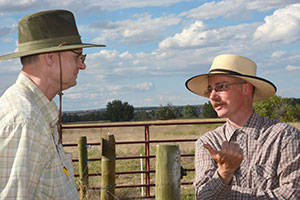
Contact Us
Institutional Communications
Bureau of Mines Building, Room 137
Laramie, WY 82071
Phone: (307) 766-2929
Email: cbaldwin@uwyo.edu
Wide-Ranging Wyoming Collaboration Targets Invasive Grasses
Published December 11, 2020

Brian Mealor, right, director of IMAGINE and director of UW’s Sheridan Research and
Extension Center, speaks with Jim Heitholt, director of UW’s Powell Research and Extension
Center, during a summer field research day. (UW Photo)
Partners that span governmental boundaries and jump private-public borders hope to throw a tight noose around invasive grasses degrading Wyoming lands and halt establishment of other invasives.
A public and private funding mix would drive the Institute for Managing Annual Grasses Invading Natural Ecosystems (IMAGINE) based in the College of Agriculture and Natural Resources at the University of Wyoming. The effort casts a broad net to confront invasive grasses, such as cheatgrass, ventenata and medusahead, through fundamental research, community science and creating what its originators call next generation partnerships.
“To take a truly comprehensive look at annual grass invasion, it requires much more than a few weed guys,” says Brian Mealor, director of IMAGINE and director of UW’s Sheridan Research and Extension Center.
IMAGINE partners include community colleges, multiple colleges and departments across the UW campus, and entities outside UW including the Wyoming Game and Fish Department, and the Wyoming weed and pest control districts.
He says next steps include forming an advisory board; discussing priority landscapes and research needs; building structure to address some of the recommendations in Gov. Mark Gordon’s Invasive Species Initiative final report; and seeking additional funding.
The governor’s report is available at https://governor.wyo.gov/.
The broad collaboration will increase the odds of success against invasive grasses, says Barbara Rasco, dean of the UW College of Agriculture and Natural Resources.
“This is a problem that needs immediate attention,” she says. “As stated in the report, those who depend directly on the land for their livelihoods are not the only people impacted. The public also depends on and expects the benefits provided by functioning and healthy ecosystems: clean air, clean and abundant water, habitat for wildlife, food, fiber and recreational values.”
Rasco says the effort will take advantage of expertise in the college.
“Specifically, with control of invasive species and our understanding of what is involved with the management of ecosystems on a large scale,” she says.
IMAGINE involves on-the-ground experts and those managing lands to create not only the science needs, but the structure to best deliver new information to those who can use it, says Mealor, an associate professor in the college’s Department of Plant Sciences.
The effort would change traditional research models.
“Historically, our research/engagement model has been ‘tell us what you want to know, we’ll do the research, and give you the results in several years,’” he says. “The science-practice gap is relatively large in that model.”
The group wants to narrow that gap to where science and practice are difficult to separate.
Rather than using many small research plots to learn what management methods work, IMAGINE would work within landscape-scale management projects to collect and analyze data at larger scales and over longer time frames, Mealor says.
“All of which requires planning and partnership for the life of some of those programs,” he says.
Mealor notes a diverse team will help better understand invasive grass impacts ranging from changes in soil microbial communities to landscape-scale distribution patterns to socioeconomic impacts and benefits of control.
“This thing doesn’t work without cooperation,” he says.
Slade Franklin, weed and pest coordinator with the Wyoming Department of Agriculture, agrees.
“By building on the unique relationship the College of Agriculture and Natural Resources and the Wyoming weed and pest control districts already has, IMAGINE will improve the reciprocal flow of data and knowledge between university researchers and land managers,” Franklin says. “This will not only provide a benefit to the state of Wyoming, but it will be valuable to many of Wyoming’s neighboring states.”
The effort is being paid for by public and private funding. Budget-challenged times mean private support will be a sustaining backbone for public-private partnerships, says Craig Russow, a major gift officer with the UW Foundation.
The ability to expand research depends on creating chairs and positions at UW to initiate and create meaningful research, and get those results to Wyoming producers, he says.
IMAGINE will bring together partners that may not normally sit at the same table, Mealor says.
Using community science could reap big benefits.
“Each year, unplanned experiments take place on thousands of acres of Wyoming -- weed control treatments, burns and shifted grazing patterns -- and little to no data are collected to see what their impacts were,” he says. “If we are able to work together within those projects to learn more from them, while combining that information with designed, replicated studies in strategic locations, our knowledge base and predictive abilities around managing annual grass invasion will increase tremendously.”
For more information, call Mealor at (307) 673-2856.
Contact Us
Institutional Communications
Bureau of Mines Building, Room 137
Laramie, WY 82071
Phone: (307) 766-2929
Email: cbaldwin@uwyo.edu
